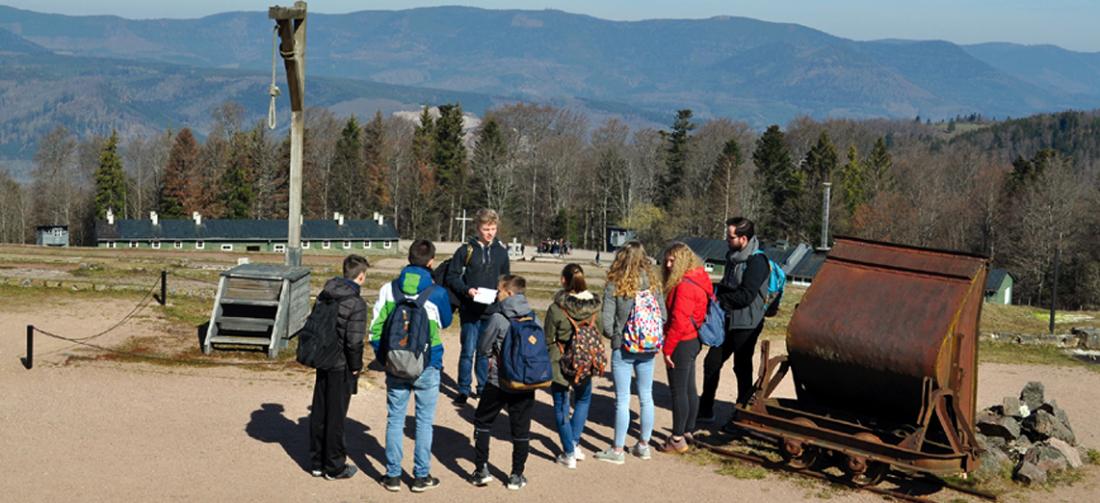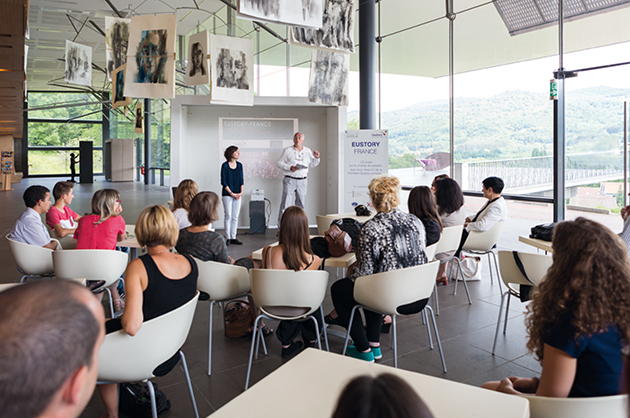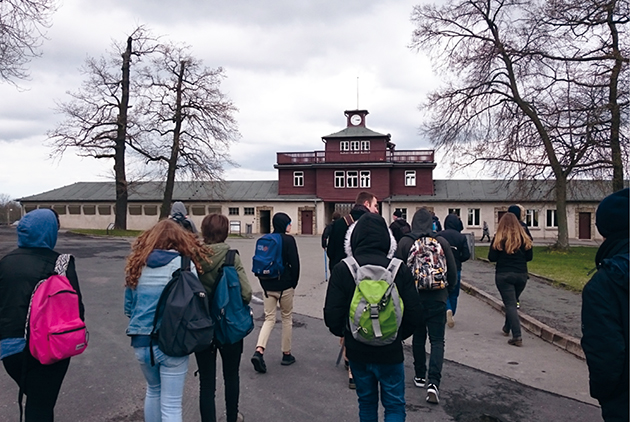European “bearers of memory”

Wars are often born out of mutual representations, feelings of reciprocal hate and the desire for revenge between populations, rationales to which young people are particularly susceptible. In an attempt to contain them, after the end of the Second World War the French and West German governments put in place an ambitious reconciliation policy centred on youth exchanges. The policy has been in place ever since, and today embraces a European perspective.
Young people often play a special role in cross-border reconciliation processes, and Europe is no different in the relationship between France and Germany. While young people may not have experienced historical conflicts as victim or aggressor, they have nevertheless been marked in their respective societies by a particular, often nationalistic, perspective on those conflicts. If differing points of view are confronted as part of constructive dialogue, it can change a great deal for the present and future of those participating. Well beyond the actual group of participants, the exchange also has a positive impact on the construction of memory in societies.
The key question is in what ways and in what places do international youth exchanges play a positive role in reconciliation and shared remembrance between France and Germany, as well as more generally in Europe. To come up with an answer, a three-pronged approach can be taken. To begin with, a brief historical classification of the development of Franco-German remembrance and reconciliation among young people is needed. Next, a discussion of current projects and practical aspects of the exchanges, followed by five possible programmatic criteria for those exchanges. The issue here is fraught with tensions: it is subject to the results of the research carried out to date on international youth exchanges concerned with history and held at historic sites, while also being influenced by the practice of those exchanges and seeking to develop practical objectives.
The Berlin 1964 Franco-German Youth Camp, Bundesbildstelle, Bonn, 1964. © OFAJ/DFJW
The origins of the Franco-German youth exchanges
“Reconciliation” is a word that is continually repeated as the slogan to sum up the work of the Franco-German Youth Office (FGYO). In terms of social policy, the notion of a “hereditary enmity” between the two neighbours, particularly prevalent in the 19th and the first half of the 20th centuries, had to be overcome. The idea of dialogue in the context of youth exchanges to drive that reconciliation does not date back to the end of the war, as French historian Mathias Delori has shown in his fundamental study on the subject.
Indeed, no later than the 1870s, various political initiatives geared to young people came into being, some concerned with world peace, others with opposing nationalist propaganda. In the second half of the 20th century, these traditional lines converged to form the Franco-German commitment of Charles de Gaulle and Konrad Adenauer, which transformed the dialogue in the context of youth exchanges. The FGYO and other key institutions were in fact created in the wake of the 1963 Élysée Treaty. That is how the process of Franco-German reconciliation also became a model for Europe, as we will explain further on.
In the early years of the FGYO, involving as many young people as possible in youth exchanges was crucial to the idea of reconciliation. Admittedly, the reassessment of a past marked by conflict, in particular by the Second World War, did play a part in the programmes of the different conferences, but it was not a prerequisite. However, during the years that followed the events of May 1968, these issues stopped receiving regularly renewed interest in the two countries, while at the same time being placed more and more in a European context.
From the 2000s, the understanding of the origins of reconciliation itself was increasingly called into question by the FGYO’s senior management: the former deputy general secretary, Michel Cullin, pointed out how important it was not merely to go on celebrating the (successful) process of reconciliation and Franco-German friendship, but to enter into a dialogue about a past that was both shared and divisive. It was also in this period that the Widerstand (resistance) programmes, concerned with exiled Germans in France, became better organised and promoted.
Trinational programmes also played an increasingly important role, beginning in the 1990s – initially with partners from Central Europe, then later also from Southeastern Europe and North Africa. These exchanges were an opportunity to look in greater depth at historical issues relating to the Second World War – in trilateral collaboration with Poland. One example is a series of three conferences that took place between 2002 and 2004, in Paris, Berlin and Krakow. Students from the three countries not only had an intercultural experience, but jointly put questions to survivors from the period and visited remembrance sites and monuments, like the Auschwitz concentration camp. Discussions of historical questions and memory were often complemented by references to the current context, which once again gave them new relevance for the present and the future. The conference referred to provided an opportunity to examine the preconceptions which participants had about one another – in contrast to the actual experiences they had had during their time together. Today, issues relating to democracy, human rights and European integration regularly play an important part in similar projects.

Award ceremony for the 2014-15 Franco-German school history competition, at the Alsace-Moselle Memorial (Schirmeck). © Alex Flores
Birth of similar initiatives
The “success” of the Franco-German Youth Office inspired the creation of similar institutions. The German-Polish Office is a case in point, which since its creation in 1991 has stressed the importance of historical-political education, with a particular focus on the period 1933-45. While it is true that the emphases differ slightly from those of the FGYO – and at times the chosen methods too – the idea of two neighbouring European countries that were formerly enemies achieving reconciliation through youth exchanges nonetheless remains the same. Meanwhile, the work done by these two organisations on remembrance has seen many parallels and has also given rise to joint projects and programmes, like the three conferences in Paris, Berlin and Krakow mentioned above.
Mention should also be made of more recent European projects, these, too, inspired by the FGYO: for instance, the Regional Youth Cooperation Office in the Western Balkans, and the youth exchange programmes currently being set up between Germany and Greece, and Germany and Israel. Here, too, reconciliation and remembrance play a crucial role. The meetings often take place on historic sites of conflicts or massacres, and give participants the opportunity to talk about these themes.
The First World War centenary was a major focus of the Franco-German youth exchanges of the past decade; not only were young people included in the remembrance events, for example at Verdun, but they were also active themselves. It is worth highlighting here a series of key events and events of lesser importance, such as those also mentioned in the interview with the FGYO for this special issue (pp. 140-145), as well as giving some practical examples that go beyond these. One such example is the Franco-German history competition, EUSTORY-France, which since its pilot edition in 2012 has used an Enquiry-Based Learning approach to confront multiple perspectives from the angle of local and regional history. The four editions of the competition held between 2014 and 2019 were on the theme of the First World War. The competition offers French learning groups the chance to work together with their German counterparts on a joint entry. The winners then have the opportunity to apply to take part in an international conference on a historical theme with the EUSTORY network, whose member organisations run competitions involving participants in more than 20 European countries. Here, too, the “Europeanisation” of remembrance is made tangible through youth exchange.
Other practical examples concern the resources made available to participants and group leaders at these conferences: an educational guide to history and remembrance at the youth exchanges (2015) and a manual on speech in connection with the First and Second World Wars (2016) are among recent publications in French and German. There is also continuing education provision that disseminates specific resources, making them available in the future. But there is also a need to provide educational support at the youth conferences: although these subjects are considered important by both sides, teachers often have difficulty deciding on a given subject if they do not have a background in history or have no prior experience. Therefore, for a youth exchange to be successful, it is wise to collaborate with education officers from museums, memorials or organisations active in this field, as well as making documentation available.

Secondary students from the department of Pas-de-Calais on a school trip to Buchenwald.
© La Coupole, Centre d’Histoire et de Mémoire du Nord–Pas-de-Calais
Some keys to success
Based on these historical considerations and practical examples that can be considered “best practice”, it is important to emphasise what makes for a successful European youth exchange on a historical theme. From planning the site, format and references of the exchange through to its moral basis, there is a lot to discuss and bear in mind.
Five priorities can be underlined:
- Preparation and support: it is important for young people to be thoroughly prepared for the exchange. This means, on the one hand, knowing their own history and on the other, being emotionally prepared for visits to sites of conflict and massacres.
- Authenticity of the sites: international youth exchanges presuppose that at least one of the groups will leave their familiar environment. However, even more can be learned when the groups change sites during an exchange (for example, with home and away meetings), and visit sites where the events took place, even if those sites have been preserved in their original state. Rediscovering familiar sites, in the light of the historical events that took place there, can be very rewarding.
- Active and creative appropriation: youth exchanges are particularly productive when what is likely an abstract history becomes personal. In France, for example, there is a far more vivid family memory than in a great many German families. Even so, researching your own family or the people where you live can make many processes more tangible. Such an approach also gets people actively involved. If this approach is followed by a creative representation in the form of a film, exhibition, artwork or other, the intercultural learning process is often particularly long-lasting.
- Connection to the present and the world around us: this appropriation of the subject is further complemented by a topical dimension, consisting of discussing the way in which the media approaches the past and the present (fake news, conspiracy theories, etc.), as well as issues like democracy, discrimination and exclusion. Making these connections is very valuable in terms of historical education, while it is important not to put historical developments and the present on the same footing.
- Focus on understanding and memory: in the past, there was an increasingly established conviction that the aim of these exchanges could not and should not be to persuade young people to carry out “acts of reconciliation” or other similar things. Young people today ultimately have no direct responsibility for the acts committed by their forefathers, and therefore cannot and should not apologise. For that reason, the exchanges must strive for mutual comprehension; after all, it is at this level that remembering the past is possible within the group.
Franco-German reconciliation through youth projects could be described as “ancient history”, for these initiatives are part of a long tradition. But that history also shows how such youth exchanges must always be rethought in terms of content and method, and continually developed, the five priorities set out above representing only a possible contribution. It is still worth noting, however, the huge potential which these exchanges have for remembrance, and their relevance to the present and the future.

